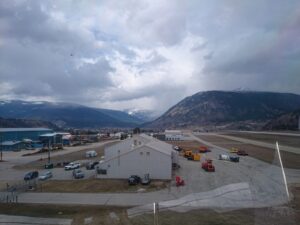With the start of the summer weather comes the beloved first flight of the season. The amount of excitement I had for today’s flight was no different than any other year. After some quick flight planning, a thorough walk around, a short stop at the fuel station, and a thunderous run-up, I was ready to taxi to the end of the runway. Taxiing the amphibious 206 always feels somewhat laborious when starting from a dead stop, but once it gets moving, it’s pretty maneuverable.
Now sitting at the end of the runway, I gradually increased the power as I listened to the engine’s roar, trying to compete with the deafening noise of the three-bladed propeller beating the air into submission. Without hesitation, the Cessna began its roll for the skies as my eyes moved to watch the airspeed indicator climb. Thirty knots, forty knots, then fifty, and off we go! What a fantastic feeling it is to leave the earth once again and soar like a bird. Another successful, uneventful takeoff, I thought to myself with a smile as I climbed into the circuit.
I had planned to take today pretty easy. Complete a few circuits at the airport, then splash around in some lakes. Since this was the first flight in a little while for the aircraft, I had heard that it’s best to keep the wheels down on the first flight (or circuit in my case) just in case they don’t operate correctly. So that’s what I did. I completed a nice little circuit around the airport and landed successfully. Everything is feeling great! I then took off again and completed another three circuits, cycling the gear on each lap to ensure everything was moving the way it should. Again, no problems here.
At this point, I’ve decided that I was ready to find some lakes and have some fun. I completed one last takeoff from the asphalt, set my heading bug to the northeast, and climbed even higher into the gorgeous blue skies. About twenty minutes later, I was above my first large lake. I completed a low-altitude fly-over to verify that my planned landing area was safe and clear of debris and traffic. I then configured the aircraft for a standard flap-30° water landing, making sure to double and triple check the wing mirrors that my wheels were up. Everything was looking perfect as I gently lowered the aircraft onto the water.
Splash! An uncontrollable grin spread across my face as I completed my first water landing of the season. I can’t get enough of the excitement this type of flying brings me. With such a great feeling in my chest, I decided to shut down and drift for a short while to enjoy the moment further. With the engine off, I reclined my chair for optimal relaxation and enjoyed the quiet, beautiful day on the water.
Soon, the itch to get in the air was back again, and I quickly started the ol’ Continental engine and took off in search of another few lakes to play around in. I completed another four takeoffs and landings in nearby lakes and decided it was time to head home. On the flight back, I thought about all the places I wanted to explore and how much fun I’ll have doing it. This was the start of a great summer!
Within twenty minutes, I was back above home base and crossed the field to join mid-left downwind. Nearing the end of this leg, I selected flaps ten and continued my circuit. As I banked into my base leg, I selected flap twenty and gear down. I waited a few seconds and glanced at my gear indicator; all the lights still glowed blue. Weird! I grabbed the gear lever, selected gear-up, then back down again—still nothing. I then turned the aircraft onto final and made a radio call that I’ll be overshooting the runway followed by a departure from the circuit so I could troubleshoot this in a more controlled environment.
I tried moving the gear selector back and forth a few times to see if that might trigger something. Nothing happened, though. I selected gear down again and reset the hydraulic gear pump circuit breaker thinking that a momentary power interruption might jumpstart the pump into operation. Again, nothing happened. I continued to fly on a straight and level path as I debated my options. I know I have an emergency manual gear-extension pump for this scenario, but the possibility that not every wheel would extend and lock into position came to mind. At the moment, all my wheels were up and locked, so I knew I could safely land on the water and deal with it dockside. I wasn’t sure where I could find a suitable dock, but I knew if I attempted a manual gear-drop, I removed the option to land on water.
I thought about this for a few moments, but I decided that the chances of a wheel not locking when fully extended were tiny, given the fact that I had cycled them many times earlier that day. I grabbed the emergency pump handle, unscrewed it and started pumping. Not much seemed to happen, but about twenty or so pumps later, one of the blue gear lights extinguished. I can’t change my mind now. I must get all the wheels down. I continued pumping as I continuously ensured that I was still flying safely and reasonably. I’ve studied too many accidents where the crew were so fixated on a problem that they forgot to fly the aircraft. Eastern Air Lines Flight 401 is a famous one where the crew crashed a 100% operable aircraft into the Florida Everglades because they were distracted by a burnt-out gear indicator light.
After about eighty or so pumps, two blue gear lights remained illuminated, and I quickly realized that the 200 pumps I was told I would have to perform might be underestimated. So I kept at it, and as I pushed in another few pumps, I felt a familiar shake and saw that the last two blue lights turned off as the red “pump on” light shined. Within seconds, the four green lights illuminated one by one, and the red light extinguished! The pump had come to life and finished the repetitive arm exercise I had committed to. With the hydraulic lines now completely pressurized, I could not push the pump back into its stow position, meaning that the wheels must have been fully extended and locked. I looked out the window at the mirrors once more and determined that the wheels appeared to be in the position they usually are for asphalt landings. I can finally return to the airport and call it a day.
I made a few radio calls and turned back towards the circuit for my final landing. I configured the aircraft without issue this time (having left the gear down) and made a smooth landing on the north-facing runway. Thankful to be safe on the ground, I taxied into the hangar, completed the logbook, and informed my mechanic that they should double-check the gear on the annual. The following drive home was full of my own cheers for me as I was thankful that I felt that I had handled that situation well.
Today was a good day. I loved getting back out there, remembering what it’s like to see the land from above and splash around in the water. I thought the gear issue was a great learning experience for what it is, and I was thankful that, in the end, I was safe at home.


